Intro
The importance of understanding the ingredients in medications cannot be overstated, especially when it comes to antibiotics like cefdinir. Cefdinir, an antibiotic belonging to the cephalosporin class, is widely used to treat various bacterial infections. Its effectiveness in combating infections has made it a staple in many healthcare settings. However, knowing what cefdinir is composed of can help patients and healthcare providers make informed decisions about its use, especially for individuals with specific allergies or dietary restrictions.
Cefdinir's mechanism of action involves inhibiting the synthesis of the bacterial cell wall, leading to the death of the bacterial cells. This action is specific to bacteria, making cefdinir an effective treatment for bacterial infections without causing significant harm to human cells. The drug's composition includes the active ingredient cefdinir and various inactive ingredients that may vary depending on the formulation. Understanding these components can provide insights into potential side effects, interactions, and contraindications.
The use of cefdinir, like any other medication, should be guided by a thorough understanding of its benefits and risks. Patients should be aware of the potential for allergic reactions, gastrointestinal side effects, and the importance of completing the full treatment course to prevent the development of antibiotic-resistant bacteria. Moreover, the interaction between cefdinir and other medications or foods can impact its efficacy and safety profile. Therefore, a comprehensive review of cefdinir's ingredients and their implications is crucial for maximizing its therapeutic benefits while minimizing its risks.
Cefdinir Composition
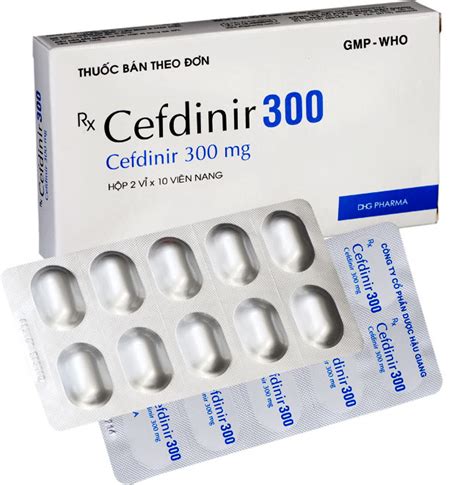
Cefdinir is composed of the active ingredient cefdinir and several inactive ingredients. The active ingredient, cefdinir, is a semi-synthetic cephalosporin antibiotic with a broad spectrum of activity against Gram-positive and Gram-negative bacteria. The inactive ingredients in cefdinir formulations can include fillers, binders, lubricants, and stabilizers, which are added to enhance the drug's stability, bioavailability, and patient acceptability. Common inactive ingredients in oral cefdinir formulations include microcrystalline cellulose, sodium starch glycolate, and magnesium stearate.
Active Ingredient: Cefdinir
The active ingredient in cefdinir, also known as cefdinir, is chemically known as (6R,7R)-6-(2-(2-amino-4-thiazolyl)glyoxyamido)-3-ethyl-8-oxo-5-thia-1-azabicyclo[4.2.0]oct-2-ene-2-carboxylic acid. This complex chemical structure is responsible for cefdinir's antibacterial activity, which involves binding to penicillin-binding proteins located inside the bacterial cell wall, resulting in the inhibition of cell wall synthesis and ultimately leading to bacterial cell death.Cefdinir Mechanism of Action
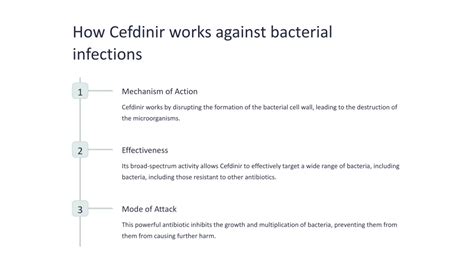
Cefdinir's mechanism of action is characterized by its ability to inhibit bacterial cell wall synthesis. The bacterial cell wall is essential for maintaining the structural integrity of the cell and preventing the influx of external substances. By inhibiting the synthesis of this critical component, cefdinir effectively compromises the viability of bacterial cells, leading to their death. This action is highly specific to bacteria, making cefdinir a valuable therapeutic option for treating bacterial infections without causing significant harm to human cells.
Pharmacokinetics of Cefdinir
The pharmacokinetics of cefdinir, including its absorption, distribution, metabolism, and excretion, play a crucial role in determining its efficacy and safety profile. Cefdinir is orally administered and exhibits good bioavailability, allowing it to reach therapeutic concentrations in the bloodstream and tissues. It is primarily excreted unchanged in the urine, with a half-life that supports twice-daily dosing. Understanding the pharmacokinetics of cefdinir is essential for optimizing its dosing regimen and minimizing the risk of adverse effects.Cefdinir Uses and Indications
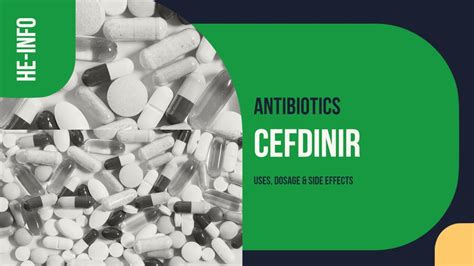
Cefdinir is indicated for the treatment of various bacterial infections, including community-acquired pneumonia, acute exacerbations of chronic bronchitis, acute maxillary sinusitis, pharyngitis, and uncomplicated skin and skin structure infections. Its broad spectrum of activity against both Gram-positive and Gram-negative bacteria makes it a versatile antibiotic for managing a range of infections. However, the use of cefdinir should be guided by susceptibility testing and clinical judgment to ensure appropriate treatment and minimize the development of antibiotic resistance.
Cefdinir Dosage and Administration
The dosage and administration of cefdinir are critical factors in ensuring its efficacy and safety. The recommended dosage of cefdinir varies depending on the infection being treated, with typical adult doses ranging from 300 mg to 600 mg every 12 to 24 hours. Cefdinir should be taken with food to enhance its absorption and minimize gastrointestinal side effects. Patients should complete the full treatment course as prescribed, even if symptoms improve before the end of treatment, to prevent the development of resistant bacteria.Cefdinir Side Effects and Interactions
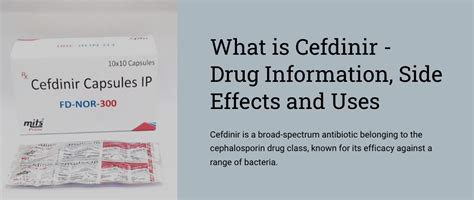
Like all medications, cefdinir can cause side effects and interact with other drugs or foods. Common side effects of cefdinir include diarrhea, nausea, and vomiting, which are usually mild and transient. However, cefdinir can also cause more serious side effects, such as allergic reactions, Stevens-Johnson syndrome, and antibiotic-associated colitis. Additionally, cefdinir can interact with other medications, including antacids, histamine-2 (H2) blockers, and probenecid, which may alter its efficacy or increase the risk of side effects.
Cefdinir Allergic Reactions
Allergic reactions to cefdinir can range from mild to severe and are a significant concern in patients with a history of cephalosporin or penicillin allergy. Mild reactions may include rash, itching, or hives, while severe reactions can manifest as anaphylaxis, characterized by difficulty breathing, rapid heartbeat, and a drop in blood pressure. Patients who experience any signs of an allergic reaction should seek immediate medical attention.Cefdinir Resistance and Stewardship
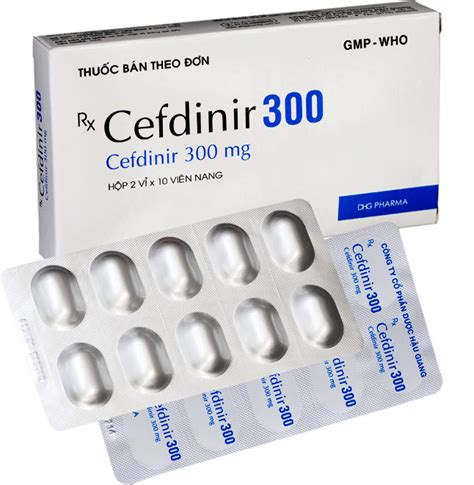
The emergence of antibiotic-resistant bacteria is a growing concern worldwide, and cefdinir is no exception. The misuse and overuse of cefdinir can accelerate the development of resistance, rendering the antibiotic ineffective against certain bacterial strains. Therefore, antibiotic stewardship programs are crucial in promoting the judicious use of cefdinir and other antibiotics, ensuring that these valuable therapeutic agents remain effective for future generations.
Strategies for Minimizing Resistance
Strategies for minimizing cefdinir resistance include using the antibiotic only when necessary, choosing the appropriate dosage and duration of treatment, and promoting practices that reduce the transmission of resistant bacteria, such as hand hygiene and proper infection control measures. Additionally, the development of new antibiotics and alternative therapies is essential for addressing the challenge of antibiotic resistance.Cefdinir in Special Populations
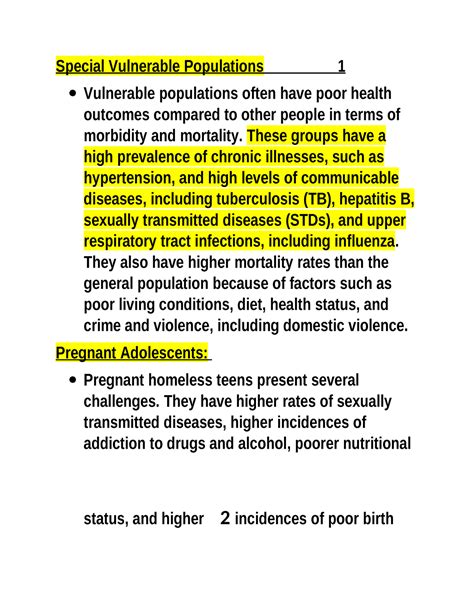
The use of cefdinir in special populations, including pediatric patients, pregnant women, and individuals with renal or hepatic impairment, requires careful consideration. In pediatric patients, cefdinir is generally well-tolerated and effective, but the dosage should be adjusted according to the child's weight and the severity of the infection. In pregnant women, cefdinir should be used with caution, as there are limited data on its safety during pregnancy. Patients with renal or hepatic impairment may require dose adjustments to prevent the accumulation of cefdinir and minimize the risk of adverse effects.
Cefdinir in Pediatric Patients
Cefdinir is approved for use in pediatric patients and has been shown to be effective in treating various bacterial infections in this population. The dosage of cefdinir in pediatric patients should be based on the child's weight, with typical doses ranging from 7 mg/kg to 14 mg/kg every 12 to 24 hours. Parents and caregivers should be advised to complete the full treatment course as prescribed and to monitor their child for any signs of side effects or allergic reactions.What is cefdinir used for?
+Cefdinir is used to treat various bacterial infections, including community-acquired pneumonia, acute exacerbations of chronic bronchitis, acute maxillary sinusitis, pharyngitis, and uncomplicated skin and skin structure infections.
How does cefdinir work?
+Cefdinir works by inhibiting the synthesis of the bacterial cell wall, leading to the death of the bacterial cells. This action is specific to bacteria, making cefdinir an effective treatment for bacterial infections without causing significant harm to human cells.
What are the common side effects of cefdinir?
+Common side effects of cefdinir include diarrhea, nausea, and vomiting, which are usually mild and transient. However, cefdinir can also cause more serious side effects, such as allergic reactions, Stevens-Johnson syndrome, and antibiotic-associated colitis.
In conclusion, cefdinir is a valuable antibiotic for treating various bacterial infections, but its use should be guided by a thorough understanding of its composition, mechanism of action, and potential side effects. By promoting the judicious use of cefdinir and other antibiotics, we can help ensure that these therapeutic agents remain effective for future generations. If you have any questions or concerns about cefdinir or any other medication, do not hesitate to reach out to your healthcare provider. Share this article with others to promote awareness about the importance of antibiotic stewardship and the responsible use of antibiotics.
